Enhance Your Poolside: Potted Plant Ideas & Tips
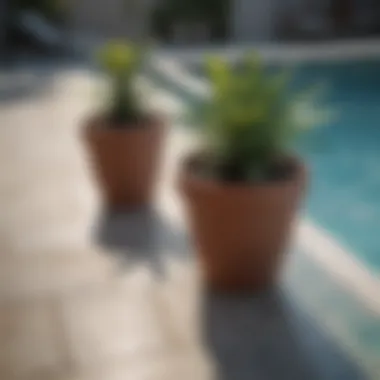
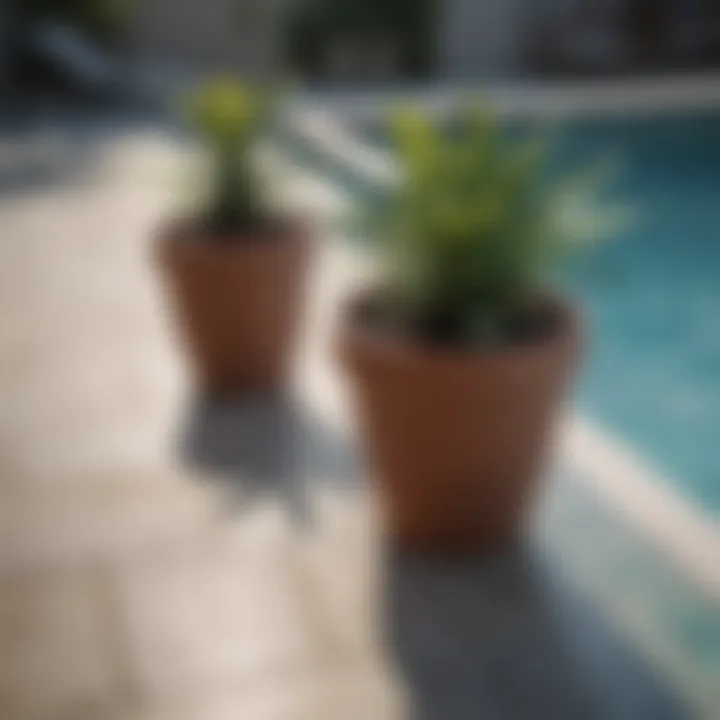
Intro
Incorporating potted plants around pools is more than just an aesthetic choice. It enhances the overall ambiance and transforms outdoor spaces into relaxing retreats. This guide aims to explore the multiple facets of using potted plants in pool areas, giving homeowners, design aficionados, and gardening enthusiasts the insights needed to create beautifully harmonious environments.
Considerations for Choosing Plants
Selecting the right plants involves understanding both practical and aesthetic aspects. Some plants tolerate humidity well, while others thrive in full sun, making their placement crucial. Apart from these functional choices, the visual appeal of the selected plants should mesh seamlessly with the overall poolside design.
Establishing the Atmosphere
Greenery contributes to a refreshing atmosphere. Lush plants can provide a calming presence that contrasts stark, sunny surfaces. Whether your goal is to create a resort-like setting or a cozy backyard oasis, the choices you make in plant selection will dictate your space's personality.
Prelims
Incorporating plants in pots around swimming pools presents both aesthetic and functional enhancements to outdoor spaces. This article aims to explore these benefits and considerations deeply. The presence of greenery not only softens the hard surfaces of pools but also introduces a natural element, creating a more inviting atmosphere.
The Role of Plants in Outdoor Spaces
Plants serve multiple roles in outdoor environments. They provide shade and comfort, act as natural air purifiers, and attract beneficial wildlife. Using various plant species can enhance the biodiversity of your area, promoting an ecological balance. Particularly around pools, plants underscore the overall design theme while contributing to effective temperature regulation. The careful selection of plants can create a visually appealing landscape, transforming what may be a stark pool area into a lush retreat.
The Appeal of Potted Plants Around Pools
Potted plants around pools offer a unique blend of versatility and aesthetic appeal. Unlike in-ground planting, pots can be moved to optimize sunlight exposure or to change the look of the space. This is especially beneficial for seasonal plants, allowing for changes in decor throughout the year. Additionally, pots come in varied materials, shapes, and sizes, allowing for a custom fit that complements the pool area.
"Incorporating potted plants gives homeowners the flexibility needed to adapt their outdoor environment to personal taste and seasonal changes."
Moreover, the use of potted plants can prevent soil erosion that might occur from heavy watering. It is also essential to choose plants that can thrive in the proximity of water, as they can add color and vibrancy to the poolside environment. Overall, using potted plants creates a harmonious and lively outdoor space.
Selecting the Right Plants
Selecting the right plants is crucial when incorporating greenery around pools. The choice of plants impacts not just aesthetics but also the functional dynamics of the outdoor space. Plants can provide shade, create a soothing atmosphere, and even contribute to privacy. Understanding how various plants thrive near water features can enhance the overall appeal while ensuring minimal maintenance and pest control.
Before selecting plants, it is essential to take several factors into consideration, such as the local climate, sunlight exposure, and space constraints. Behavior of the plants regarding water retention and size is vital since an unsuitable choice may lead to overwhelming growth or the opposite—plants struggling to survive. With careful selection, one can create a landscape that balances nature and the pool’s serene environment.
Considerations for Plant Selection
When it comes to plant selection, several key considerations can guide your choices. First, evaluate the sunlight exposure of the pool area. Some plants thrive in direct sunlight, while others prefer shade. Identifying the microclimates can ensure plants receive the appropriate amount of light.
Soil type also holds importance; well-drained soil is typically better for potted plants. This helps avoid root rot, especially in a humid environment near water. A plant’s growth habit is another factor. It's wise to choose varieties that will not outgrow their containers quickly or require excessive pruning.
Moreover, consider the overall look you wish to achieve. Some people prefer a lush tropical feel, while others like minimalist designs. Ultimately, the plants you select must not only enhance the visual appeal but also work harmoniously with your outdoor setting.
Best Plants for Poolside Environments
Succulents
Succulents are an excellent choice for poolside environments due their low maintenance. These plants store water in their leaves, making them ideal for warmer climates and direct sunlight. One key characteristic of succulents is their unique ability to thrive in poor soil conditions. This can be advantageous because it minimizes the need for frequent fertilization. However, overwatering can be detrimental, so a proper balance in care is necessary.
Tropical Plants
Tropical plants add a vibrant ambiance to any poolside setup. Their lush foliage and colorful blooms often evoke a sense of paradise. A notable characteristic is their ability to create shade, which can be refreshing for pool users. However, they typically need frequent watering and may require extra care to prevent pests. The appeal they bring can outweigh the extra maintenance involved.
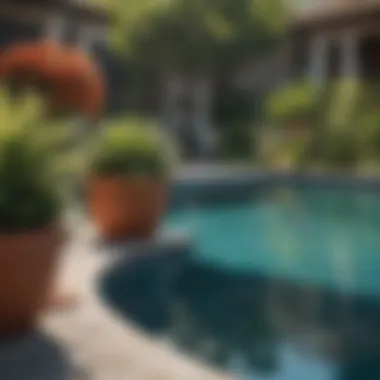

Herbs
Herbs can serve multiple purposes around pools. They offer aromatic qualities, which can enhance the sensory experience while socializing outdoors. Well-known varieties like basil and mint not only work well in pots but can also be used in food and drinks, adding practicality. Generally, herbs prefer well-drained soil and can thrive in sunny spots. However, their reliance on regular watering requires careful attention to ensure they do not dry out.
Ornamental Grasses
Ornamental grasses bring movement and texture to poolside landscapes. They come in various heights and colors, contributing to a natural look. These plants are also drought-tolerant, making them an easy choice for busy homeowners. The unique feature of ornamental grasses is their ability to sway gently in the wind, which can add a calming effect to the environment. Though they generally require low maintenance, it is important to be cautious as some may spread more than intended.
Avoiding Plants That Attract Pests
When selecting plants for poolside environments, it’s vital to avoid species known for attracting pests. Certain flowering plants can lure insects, which may interfere with the enjoyment of outdoor spaces. Additionally, some plants produce a high level of resin or sap that can create sticky situations. By being informed about the plants that commonly attract pests, you can maintain a more comfortable and relaxing atmosphere around your pool.
Design Strategies
Incorporating plants in pots around pools is not just about aesthetics; it is also about creating an inviting and functional outdoor space. The design strategies you employ will determine how well the plants blend with the surroundings. This section discusses key elements like visual balance, layering, and choosing the right containers. These strategies are essential to enhance the beauty and usability of your pool area.
Creating Visual Balance
Visual balance is crucial when arranging plants around your pool. Without it, the space can feel cluttered or disorganized. When planning your layout, consider symmetry and asymmetry. For example, placing larger pots on one side can be balanced by using smaller pots on the opposite side. This arrangement can create a harmonious look.
Additionally, varying the heights of plants can contribute to balance. Tall plants can be placed at the back or center, while shorter ones can adorn the forefront of the space. This layering will lead the eye naturally through the area. The goal is to evoke a sense of calmness, making the pool area a relaxing escape.
Layering Plants for Depth
Layering plants is an effective way to create visual depth, important for an appealing landscape. Using diverse plant heights allows for a more dynamic appearance. When layering, combine tall plants such as palms or ferns with medium-sized plants like hydrangeas or coleus, alongside shorter ground cover plants. This approach creates an engaging backdrop for the pool, enriching the overall aesthetic.
Consider also the plants’ textures and colors. Variety in foliage can further enhance depth. For instance, pairing broad-leaved plants with fine-textured options can create contrast, allowing each plant to shine individually while contributing to the overall design.
Choosing Containers that Complement Your Pool Area
Choosing the right containers is as critical as selecting the plants themselves. Containers must not only serve a functional purpose but also enhance the aesthetic of your pool area. Several factors like materials, colors, and sizes play a significant role in this decision-making process.
Materials
The material of the containers significantly impacts their longevity and visual appeal. Common materials include ceramic, plastic, wood, and metal. Each has its distinct feature. For example, ceramic pots offer an elegant look but can be heavy. On the other hand, plastic pots are lightweight and versatile but may lack a sophisticated finish. It is important to choose containers that are durable and suitable for outdoor conditions. The right material can also set the tone, whether casual or refined.
Colors
Colors can dramatically influence the mood of your pool area. Opt for colors that complement the water and surrounding landscape. Neutral tones such as beige and gray can provide a subtle backdrop to vibrant plants. In contrast, bold colors like turquoise or bright red can create striking focal points. When selecting colors, consider the overall theme of your outdoor space. The unique features of colors can either blend into the environment or stand out to create visual interest.
Sizes
Size is another essential aspect of container selection. Containers should suit the scale of the plants inside them and the surrounding environment. Large pots can make a statement and anchor the design. Smaller containers can provide versatility, allowing for more varied arrangements. Furthermore, larger pots may require more soil and water, impacting your maintenance routine.
By thoughtfully considering materials, colors, and sizes when selecting containers, homeowners can create an aesthetically pleasing and functional environment around the pool. A well-planned design strategy enhances both the visual appeal and the overall experience of the pool area, creating a seamless connection between nature and leisure.
Maintenance Considerations
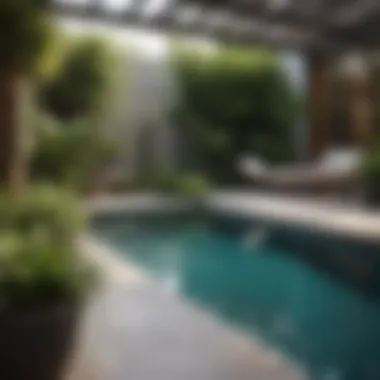
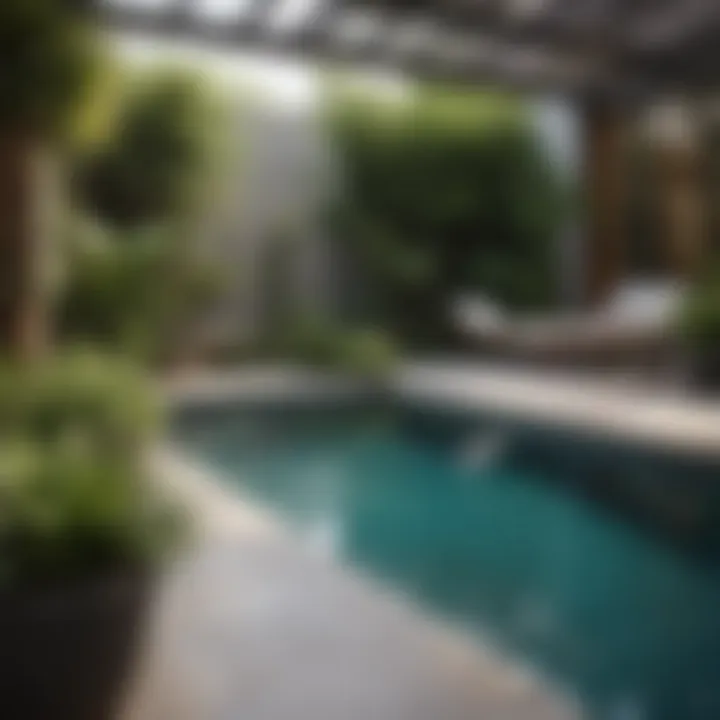
Proper maintenance is essential for any landscaping design, especially when introducing potted plants around pools. The need for maintenance stems from the environmental challenges that come with poolside conditions. High temperatures, humidity, and the presence of chlorine can affect plant health.
By focusing on maintenance, homeowners can enhance both the aesthetic and functional benefits of their outdoor spaces, ensuring that plants thrive while also contributing to a pleasant atmosphere for relaxation and gatherings. Regular care prevents potential issues like pest infestations, overgrown vegetation, and nutrient deficiencies, leading to a more harmonious setting that complements the area around the pool.
Watering Needs for Pots Near Pools
Watering is a critical aspect of plant care. Plants in pots around pools require consistent moisture, but the frequency can vary based on several factors. These include the type of plant, weather conditions, and pot size.
Generally, pots have limited soil volume, which can dry out more quickly than garden beds. Therefore, it is important to check the moisture level regularly. As a rule of thumb, most potted plants will need watering several times a week during the hotter months. However, during rainy periods, it may be sufficient to water less frequently.
To ensure that plants receive adequate hydration, consider using self-watering pots or drip irrigation systems. This can ease the burden of daily checks, allowing you to focus on enjoying your outdoor space. Remember, overwatering can be just as harmful; ensure pots have proper drainage to prevent root rot.
Fertilization Practices
Fertilization plays a significant role in the health of potted plants. Unlike garden soil, potting mixes often have limited nutrients. As plants grow, they may deplete the soil's resources, which can stunt growth and reduce flowering potential.
To maintain vibrant and healthy plants, it is recommended to fertilize regularly. A balanced, slow-release fertilizer can be applied at the beginning of the growing season. Additional liquid feedings may be required during vigorous growth periods. Observe plants for signs of nutrient deficiency, such as yellowing leaves or stunted growth, and adjust your fertilization schedule accordingly.
Organic options like compost and fish emulsion can also provide nutrients without the risk of over-fertilization and may improve soil structure over time.
Controlling Weeds and Pests
Weeds and pests can be more than just an eyesore; they can compete with your potted plants for nutrients and water. A proactive approach is key to effective weed and pest management.
While maintaining your poolside space, inspect pots regularly for signs of weeds. Hand-pulling is an effective way to control weeds, especially when done early. Using mulch around pots can also help prevent weed growth and retain moisture.
For pests, identify the specific issue before determining a course of action. Some common pests near pools may include aphids, spider mites, and scale insects. Introduce beneficial insects like ladybugs or consider organic pesticides as a last resort. Maintaining plant health through proper watering and fertilization can also make plants less susceptible to infestations.
Overall, consistent maintenance is not just about cutting back growth or watering. It involves a comprehensive understanding of plants’ needs and an active approach to their care.
By investing time and effort into these practices, the potted plants around your pool can flourish, greatly contributing to the overall beauty and enjoyment of your outdoor area.
Psychological Benefits of Greenery
Integrating plants into poolside environments extends beyond aesthetics. The presence of greenery can profoundly affect the mental and emotional state of those who spend time in these spaces. Several studies highlight the psychological benefits of interacting with plants. This section delves into how plants enhance relaxation, improve mood, and create welcoming atmospheres for social gatherings.
Stress Reduction and Relaxation
Plants can significantly lower stress levels. The simple act of being around greenery can elevate one’s sense of calm. Studies in environmental psychology assert that natural elements help reduce cortisol, the stress hormone. When positioned near pools, potted plants can create a serene retreat. The sights and smells of plants such as lavender or mint add sensory benefits. People often seek relaxation by the poolside, and incorporating plants promotes a more peaceful experience.
Moreover, the color green itself is often associated with tranquility. A lush green plant provides a contrast to the blue of the water. This visual harmony can enhance one's overall relaxation experience. Therefore, the careful selection of plants is critical. Robust foliage not only looks appealing but also can be soothing to the mind.
Enhancing Mood and Well-Being
The role of plants in improving psychological well-being is well-documented. Studies reveal that greenery can boost mood and promote feelings of happiness. Interacting with nature leads to positive emotions, which can be particularly beneficial for those who spend time outdoors. Potted plants around pools invite individuals to interact with their environment, increasing feelings of contentment.
Some plants release phytoncides, which are natural compounds that can improve mood. For example, citrus plants like lemon trees not only serve aesthetic purposes but also contribute positively to mental health. Creating a garden-like atmosphere around swimming pools can stimulate refreshment and evoke memories of carefree times. Thus, the integration of plants can lead to a more inviting and uplifting view.
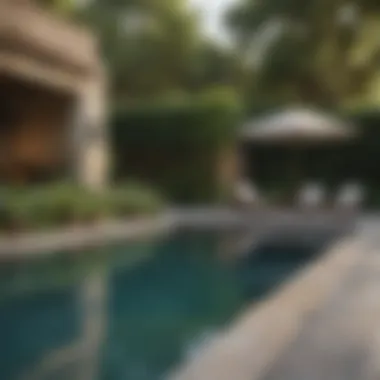
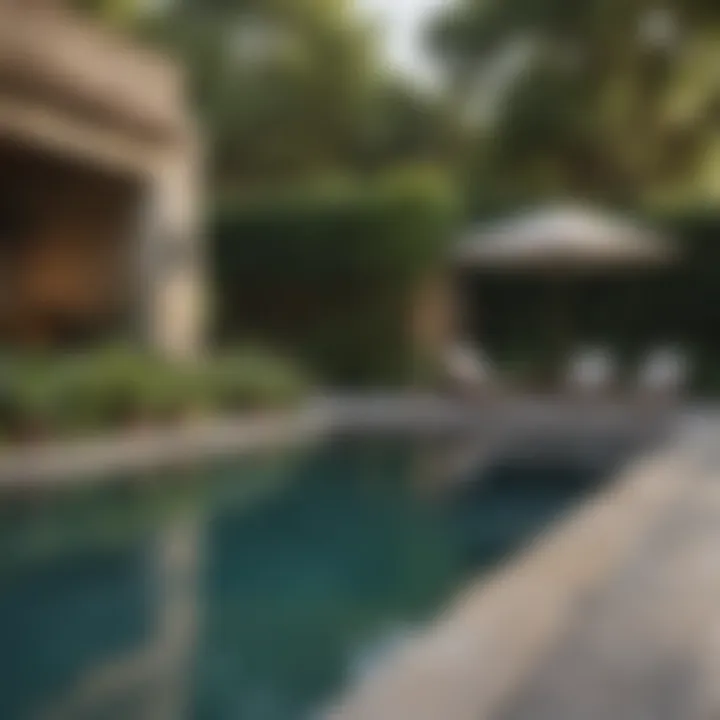
Creating an Inviting Atmosphere for Gatherings
Social gatherings around pools can be enhanced dramatically through the use of plants. An area adorned with potted greenery fosters a sense of intimacy and warmth. Guests are more likely to feel at ease in a visually appealing environment. This atmosphere encourages conversation and interaction, vital elements of enjoyable gatherings.
Utilizing various sizes and types of plants can create interest and depth. Grouping plants in clusters can enhance the space visually. Additionally, incorporating outdoor seating arrangements complemented by plants promotes relaxation and openness among guests. It invites people to linger longer and connect more deeply.
"Surrounding ourselves with plants can perfectly frame shared moments, enhancing both aesthetics and experience."
Sustainability Considerations
Sustainability is crucial when planning a poolside garden. It not only enhances the beauty of the space but also contributes to environmental health. By making thoughtful choices about plants and landscaping practices, homeowners can create an eco-friendly oasis. The integration of potted plants around pools can promote biodiversity, reduce water usage, and minimize maintenance efforts. Healthy, sustainable landscapes also enhance the quality of air and water, fostering a more pleasant environment.
Choosing Native Plants
Native plants are well-suited for local climates and soils. They require less water, fertilizers, and pesticides, making them an excellent sustainable choice. Additionally, native plants provide habitats for local wildlife, including birds and beneficial insects. Selecting plants like coneflowers and black-eyed Susans can attract pollinators while offering visual appeal.
- Adaptability: Native plants are adapted to local conditions.
- Resilience: They typically resist pests and diseases.
- Support for Ecosystems: They help maintain local biodiversity.
When incorporating native plants, consider their mature size, sunlight requirements, and seasonal changes. Planning for these factors ensures a vibrant display throughout the year.
Efficient Water Usage Techniques
Water conservation is essential for any landscaping plan, especially in areas with restrictions. Utilizing efficient watering techniques can significantly reduce water waste. Here are some methods to consider:
- Drip Irrigation: Apply water directly to the roots of the plants. This method minimizes evaporation and runoff, ensuring the plants receive adequate hydration.
- Mulching: Using organic mulch can retain moisture in the soil, reducing the frequency of watering. It also suppresses weeds, which can compete for water and nutrients.
- Rainwater Harvesting: Install rain barrels to collect runoff from the roof. This water can then be used for irrigation, promoting a sustainable approach.
Implementing these techniques will not only lower water bills but also lessen your environmental footprint.
Implementing Eco-Friendly Practices
Creating a sustainable poolside area involves adopting eco-friendly practices that minimize the impact on the environment. Here are some strategies:
- Natural Pest Control: Introduce beneficial insects, such as ladybugs or lacewings, to keep pest populations in check without chemical interventions.
- Organic Fertilizers: Use compost or organic fertilizers to enrich the soil. These options are environmentally benign and improve the soil structure over time.
- Plant Selection: Avoid invasive species that disrupt local ecosystems. Instead, opt for plants that coexist well with the native flora.
These practices contribute to a healthier garden and a more sustainable environment. By making careful choices, homeowners can cultivate a beautiful outdoor space that aligns with ecological values.
Closure
Understanding the significance of incorporating potted plants around swimming pools is essential for homeowners and design enthusiasts seeking to enhance outdoor aesthetics and functionality. This article has explored various dimensions of plant inclusion, from selecting the right plants to maintenance needs, allowing readers to make informed decisions. The combination of beauty and practicality that greenery offers can create a more inviting and enjoyable environment.
The Enduring Appeal of Plants Around Pools
The allure of adding plants around pools lies in their various benefits. They act as natural barriers and help define space, providing both visual and physical separation from surrounding areas. Potted plants don't just beautify. They also introduce texture and color, enriching the overall atmosphere. Succulents and tropical plants, for example, can thrive in poolside conditions while adding vibrance.
Furthermore, the presence of plants influences the ambiance, making it feel more secluded and private. Water features often reflect the beauty of surrounding foliage, creating stunning visual moments that homeowners and guests can appreciate.
"Integrating potted plants can redefine poolside experiences, as they enhance relaxation and leisure."
Future Trends in Outdoor Plant Designs
The future of outdoor plant designs around pools sees an inclination towards sustainability and minimalism. Homeowners are more aware of their impact on the environment, leading to a preference for native plants that require less water and are better suited to local ecosystems. This choice not only supports biodiversity but also simplifies maintenance.
Another trend includes the adoption of smart gardening solutions. These approaches utilize technology to monitor plant health and hydration levels, providing homeowners with automated care. In addition, contemporary container designs, often made from eco-friendly materials, are emerging, combining style and sustainability.
As these trends develop, potted plants will continue to evolve, meeting both aesthetic desires and environmental concerns. The integration of plants around pools remains a vital aspect of outdoor design, fostering spaces that are both beautiful and functional.















